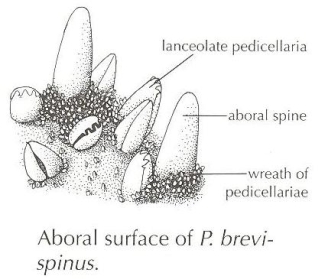Pisaster brevispinus is a large stiff-armed, pinkish-grey sea star usually found on soft substrates. It has five arms up to 32 cm long and an arm-to-disc ratio of 2.8 to 5.0. The aboral surface is a meshwork of plates with smallish spines standing alone or in clusters, with crossed and furcate pedicellariae in wreaths around the spines or standing on their own. Abundant grey or light purple papulae occur between the spines, interspersed with large lanceolate pedicellariae. The superomarginal spines are larger than the aboral spines and are separated from the inferomarginals by an obvious channel. Two or three stout inferomarginal spines have clusters of crossed and furcate pedicellariae on their distal sides. Two series of oral intermediates with stout spines also have clusters of pedicellariae on their distal sides. The adambulacrals bear a single slender spine with a tuft of pedicellariae on the plate near the base of the spine. Twelve to fifteen adambulacral plates form a long adoral carina, with mouth plates at the proximal end usually sunken and obscured by tube feet.
Characteristics
Similar SpeciesNo other five-armed sea star in this region (the area from Glacier Bay to Puget Sound to a depth to 200 metres) can match Pisaster brevispinus for size and bulk. Its smaller relative P. ochraceus is never pinkish-grey and is usually foun
